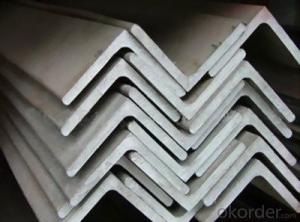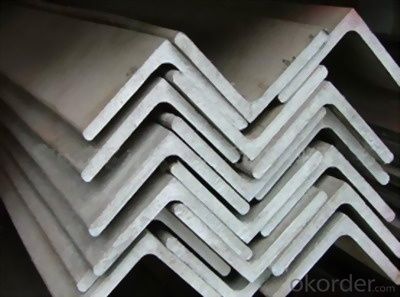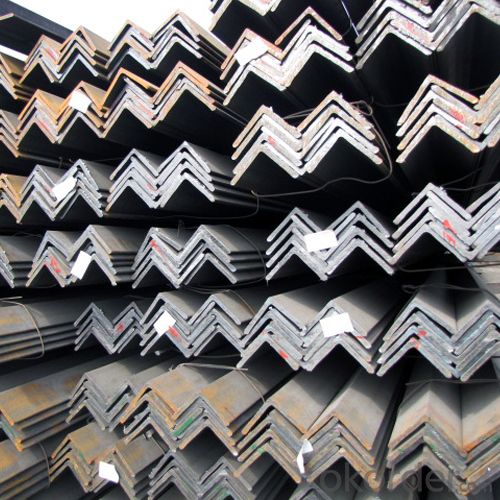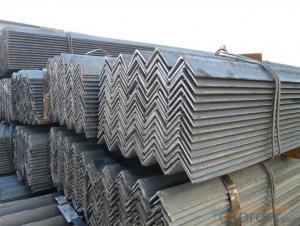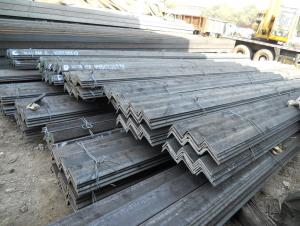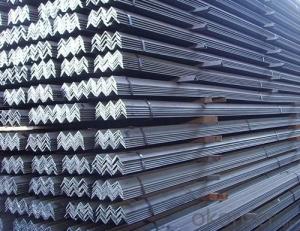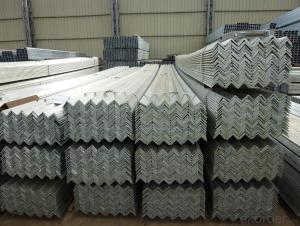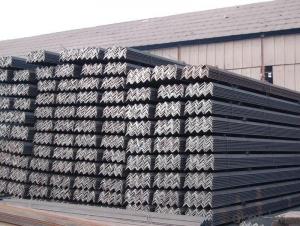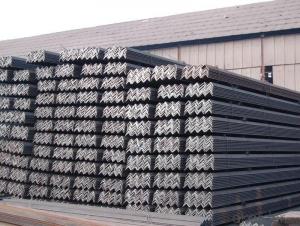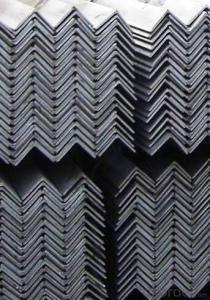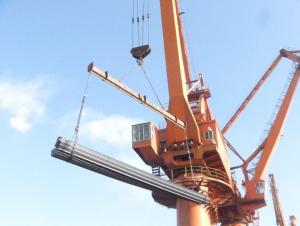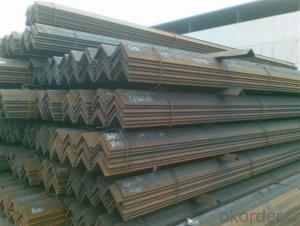SS540 Material High Quality Angle Bar
- Loading Port:
- Tianjin
- Payment Terms:
- TT or LC
- Min Order Qty:
- 25 m.t.
- Supply Capability:
- 2000 m.t./month
OKorder Service Pledge
OKorder Financial Service
You Might Also Like
Product Description:
OKorder is offering Angle Steel great prices with worldwide shipping. Our supplier is a world-class manufacturer of steel, with our products utilized the world over. OKorder annually supplies products to European, North American and Asian markets. We provide quotations within 24 hours of receiving an inquiry and guarantee competitive prices.
Product Applications:
According to the needs of different structures, Angle can compose to different force support component, and also can be the connections between components. It is widely used in various building structures and engineering structures such as roof beams, bridges, transmission towers, hoisting machinery and transport machinery, ships, industrial furnaces, reaction tower, container frame and warehouse etc.
Product Advantages:
OKorder's Angle Steelare durable, strong, and resist corrosion.
Main Product Features:
· Premium quality
· Prompt delivery & seaworthy packing (30 days after receiving deposit)
· Corrosion resistance
· Can be recycled and reused
· Mill test certification
· Professional Service
· Competitive pricing
Product Specifications:
1. Invoicing on theoretical weight or actual weight as customer request
2. Length: 6m, 9m, 12m as following table
3. Sizes
Sizes: 25mm-250mm | ||
a*t | ||
25*2.5-4.0 | 70*6.0-9.0 | 130*9.0-15 |
30*2.5-6.6 | 75*6.0-9.0 | 140*10-14 |
36*3.0-5.0 | 80*5.0-10 | 150*10-20 |
38*2.3-6.0 | 90*7.0-10 | 160*10-16 |
40*3.0-5.0 | 100*6.0-12 | 175*12-15 |
45*4.0-6.0 | 110*8.0-10 | 180*12-18 |
50*4.0-6.0 | 120*6.0-15 | 200*14-25 |
60*4.0-8.0 | 125*8.0-14 | 250*25 |
Alloy No | Grade | Element (%) | |||||
C | Mn | S | P | Si | |||
|
|
|
|
|
|
| |
Q235 | B | 0.12—0.20 | 0.3—0.7 | ≤0.045 | ≤0.045 | ≤0.3 | |
|
|
|
|
|
|
| |
Alloy No | Grade | Yielding strength point( Mpa) | |||||
Thickness (mm) | |||||||
≤16 | >16--40 | >40--60 | >60--100 | ||||
≥ | |||||||
|
|
|
|
|
| ||
Q235 | B | 235 | 225 | 215 | 205 | ||
Alloy No | Grade | Tensile strength (Mpa) | Elongation after fracture (%) | ||||
Thickness (mm) | |||||||
| ≤16 | >16--40 | >40--60 | >60--100 | |||
≥ | |||||||
|
|
|
|
|
|
| |
Q235 | B | 375--500 | 26 | 25 | 24 | 23 | |
Quality Assurance of Alloy Steel for Bearing
We are the ISO 9001:2000 authentication enterprises and we can provide the enterprise's quality written guarantee for all the exported products.
Certificate of quality is issued in English, in addition the normal terms, production process, the mechanical property (yield strength, tensile strength, elongation and hardness. forged ratio, UT test result, Grain size, heat treatment methods and the sample of is shown on the certificate of quality.
FAQ:
Q1: Why buy Materials & Equipment from OKorder.com?
A1: All products offered byOKorder.com are carefully selected from China's most reliable manufacturing enterprises. Through its ISO certifications, OKorder.com adheres to the highest standards and a commitment to supply chain safety and customer satisfaction.
Q2 Can stainless steel rust?
A2 Stainless does not "rust" as you think of regular steel rusting with a red oxide on the surface that flakes off. If you see red rust it is probably due to some iron particles that have contaminated the surface of the stainless steel and it is these iron particles that are rusting. Look at the source of the rusting and see if you can remove it from the surface.
Q3: How soon can we receive the product after purchase?
A3: Within three days of placing an order, we will begin production. The specific shipping date is dependent upon international and government factors, but is typically 7 to 10 workdays.
Images:
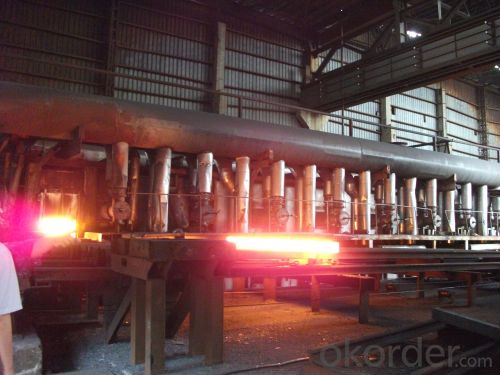
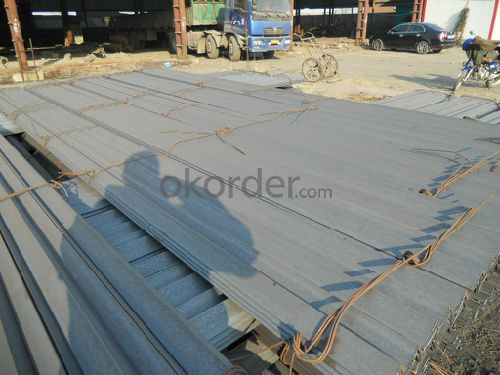
- Q: Can steel angles be used for supports in bridges?
- Yes, steel angles can be used for supports in bridges. Steel angles are commonly used in bridge construction as they provide strength and stability. They are used as vertical supports, known as piers or columns, and as horizontal supports, known as beams or girders. Steel angles offer several advantages for bridge construction, including their high strength-to-weight ratio and their ability to withstand heavy loads and vibrations. They are also versatile and can be easily fabricated and connected, allowing for efficient and cost-effective bridge construction. Overall, steel angles are a popular choice for bridge supports due to their durability, reliability, and efficiency in supporting the weight and load of a bridge structure.
- Q: What are the standard sizes of steel angles?
- The standard sizes of steel angles vary, but some common sizes include 1/2 inch, 3/4 inch, 1 inch, 1-1/4 inch, and 1-1/2 inch.
- Q: Can steel angles be used in solar panel installations?
- Yes, steel angles can be used in solar panel installations. They provide structural support and can be used to mount solar panels on roofs or other surfaces.
- Q: Can steel angles be used for framing purposes?
- Yes, steel angles can be used for framing purposes. Steel angles are commonly used in construction and engineering to provide structural support and stability. They are often used to create frames for buildings, bridges, and other structures. Steel angles can be easily welded or bolted together to form a strong and rigid frame. They are versatile and can be used in various framing applications, such as supporting walls, beams, and roofs. Additionally, steel angles are durable and have high strength-to-weight ratio, making them ideal for framing purposes.
- Q: Can steel angles be used for framing or supporting exterior façade elements?
- Yes, steel angles can be used for framing or supporting exterior façade elements. Steel angles provide structural support and stability, making them suitable for framing and supporting various components of an exterior façade, such as windows, doors, cladding, and signage. They offer strength, durability, and versatility, making them a popular choice in architectural and construction applications.
- Q: What are steel angles used for?
- Steel angles are commonly used in construction and engineering applications for providing structural support, reinforcing corners, framing, and bracing various structures such as buildings, bridges, and machinery.
- Q: What are the different types of steel angles used in signage structures?
- There are several types of steel angles commonly used in signage structures, including equal angles, unequal angles, and L-shaped angles. These angles provide structural support and stability to signage installations, ensuring durability and longevity.
- Q: Are steel angles easy to install?
- Yes, steel angles are generally easy to install. They come in pre-cut lengths with pre-drilled holes, making them convenient for various applications such as construction, framing, or manufacturing. Additionally, they can be easily fastened using screws, bolts, or welding techniques, depending on the specific installation requirements.
- Q: Are steel angles resistant to earthquakes?
- Steel angles can provide some level of resistance to earthquakes. Steel is known for its high strength and ductility, making it a suitable material for seismic-resistant construction. Steel angles, also known as steel L-shaped beams, are often used in structural applications to provide support and reinforcement. During an earthquake, steel angles can help distribute the seismic forces evenly throughout the structure, thereby reducing concentrated stress points. The L-shape design of steel angles enables them to resist bending and twisting forces, which are common during seismic events. Additionally, steel angles can be interconnected and welded together to form a rigid frame system, enhancing their seismic resistance. This system can absorb and dissipate energy from earthquake-induced vibrations, minimizing damage to the structure. However, it is important to note that the overall seismic resistance of a structure depends on various factors, such as the design, construction methods, and adherence to building codes and regulations. Steel angles alone cannot guarantee complete protection against earthquakes, but when properly integrated into a well-designed seismic-resistant system, they can significantly enhance the structure's ability to withstand seismic forces.
- Q: Can steel angles be used in mezzanine flooring systems?
- Yes, steel angles can be used in mezzanine flooring systems. Steel angles are commonly used as structural components in mezzanine floors due to their strength and versatility. They provide crucial support for the elevated floor structure, ensuring stability and load-bearing capacity. Additionally, steel angles can be easily connected and integrated into the overall mezzanine design, making them a popular choice in mezzanine flooring systems.
Send your message to us
SS540 Material High Quality Angle Bar
- Loading Port:
- Tianjin
- Payment Terms:
- TT or LC
- Min Order Qty:
- 25 m.t.
- Supply Capability:
- 2000 m.t./month
OKorder Service Pledge
OKorder Financial Service
Similar products
Hot products
Hot Searches
Related keywords
